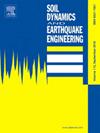A novel failure surface predictive method for low-angle submarine slopes and coupling effects with monopile foundations
IF 4.2
2区 工程技术
Q1 ENGINEERING, GEOLOGICAL
引用次数: 0
Abstract
Existing FE methods have significant limitations in simulating the stability of low-angle, low-shear-strength submarine slopes with engineering structures such as monopiles. Therefore, the present study aims to develop a novel prediction method for the potential submarine slope failure surface based on the Mohr-Coulomb criterion and the shear strength reduction method, drawing on extensive FEM and LEM simulation results. By comprehensively investigating the shear strength and stress distribution at the base of the slope, a predictive relationship between the critical reduction factor and the critical slope failure angle was established. This was then used to predict and analyse the critical failure angle in 3D homogeneous curved slopes and 3D complex real-world seabed topography. The model results and validations demonstrate the present method is robust and accurate. Furthermore, when a large slope contains multiple secondary slopes, this approach can simultaneously capture several discontinuous potential failure surfaces, addressing the non-convergence issues of FEM in these problems. Finally, the present method is used to investigate the spatial distribution of landslide areas and their impact on the stability of monopiles in offshore wind farms over a 3D topography at Silver Pit near the coast of Lincolnshire and North Norfolk, UK with historical records of submarine landslides.
求助全文
约1分钟内获得全文
求助全文
来源期刊

Soil Dynamics and Earthquake Engineering
工程技术-地球科学综合
CiteScore
7.50
自引率
15.00%
发文量
446
审稿时长
8 months
期刊介绍:
The journal aims to encourage and enhance the role of mechanics and other disciplines as they relate to earthquake engineering by providing opportunities for the publication of the work of applied mathematicians, engineers and other applied scientists involved in solving problems closely related to the field of earthquake engineering and geotechnical earthquake engineering.
Emphasis is placed on new concepts and techniques, but case histories will also be published if they enhance the presentation and understanding of new technical concepts.
 求助内容:
求助内容: 应助结果提醒方式:
应助结果提醒方式:


